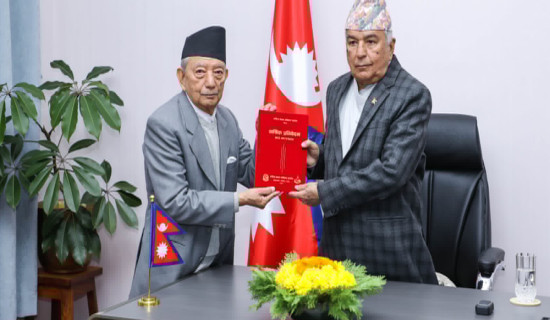- Sunday, 7 December 2025
Intra-Asian Cooperation Defines New Geopolitics
The policy of self-isolation of the USA and tariff imposition on all the nations of Asia has increased the level of economic, security, cutting-edge technologies and political cooperation among them. At the core of the foreign policy orientation of most Asian nations is the rise of China as an economic, political, military and technological superpower, its capacity to bridge the power gap with the USA and pull of its global security, civilization and development drive propelled by the Belt and Road Initiative (BRI). China makes up one-third of global industrial output, 20 per cent of the world economy and the second-largest population after India, thus leaving behind the US, Europe and Latin America, while competitive in security and security.
Asia consists of 48 nations with varied cultures. The rise of China, India, Japan, South Korea, Indonesia and Turkey is creating a post-Western world order. The West represents only 14 per cent of the world’s population, while Asia represents 4.6 billion, over 60 percent of the world's population. Asia’s share in global GDP is 55 per cent. The combined GDP of North America and Europe is 33 percent. The pivoting of the USA, Russia and Europe to the Indo-Pacific region makes a huge strategic sense. Even Latin America is pivoting to Asia, thus waning American hold in its backyard.
Regional conflict
American President Donald J. Trump and Chinese President Xi Jinping, after their phone calls, agreed to meet in person to sort out their problems and their trade representatives in London are negotiating. President Trump’s scramble for global peace is vital to escape from the geopolitical impulse that has made the Israel-Palestine conflict an epicenter of world politics. The US-Israel support to the Kurdish state may set fire to irredentist forces in Syria, Turkey, Iraq and Iran and prompt them to be engulfed in regional conflict.
India-Russia-China cooperation can dominate the geopolitical heartland of the world. They foster the nations to claim their sovereignty by escaping from Western dependence. Russia and China, in a joint statement on May 10, 2015, denounced the hegemony and power politics, expansion of NATO in Asia, favoured a multi-polar world order and promised to spur African nations’ decolonisation drive. It has supported a UN-centered international system and international law with just and equitable global governance. The pattern of Asian politics indicates the growing economic integration within the region and orientations of most nations to conduct trade with China and engage in mutually beneficial cooperation.
India, with the largest population, scientific manpower, sustained economic growth, military muscle and the fourth biggest economy of the world, has the aspiration to restore its historical glory, power, status and civilisation. As a claimant of the leader of the Global South and member of the SCO, BRICS and New Development Bank, it is reducing its trade, defense and technological dependence on the USA and orienting to Russia, Israel and France for home-grown development. The American and French reluctance to share full source code to India in the purchase of F-35 and Rafael, respectively, forced it to resort to Russia, which is offering it complete access to the source code of the SU-57 E fighter jet and SS 400. This means India will continue to rely on Russian defense technology and the import of oil despite the American threat.
Trade and investment bring China and India together. China is India’s second-largest trading partner after the USA and, therefore, it will be less likely act as a counterbalancing power in Asia to counter China. India fears China supplying HQ-19 air defense missiles to Pakistan. The USA and Turkey are also backing Pakistan. This shows that China-India ties are marked by both cooperation and competition.
Malaysia, chair of ASEAN and a recent member of BRICS, has developed close relations with India and China. It once maintained balancing ties between the USA and China but now it is veering towards China in connectivity, trade, defense and diplomacy. China is Malaysia’s largest trading partner, nourished by China’s huge investment, mutual visa-free policies and people-to-people exchange. Bilateral trade between them stands at $212 billion.
The cooperation between them will grow further with the formation of new trade bloc consisting of China, the Association of Southeast Asian Nations (ASEAN) and the Gulf Cooperation Council (GCC) aiming to achieve collective resilience, economic synergy and a shared vision for prosperity rooted in global standards of openness, development cooperation and cross-civilisation integration. Growing intra-regional trade will offset the loss incurred by rising tariff barriers of the USA.
Following the freeze of USAID, criticism of the Cambodian government for human rights violations and American imposition of 49 per cent tariffs, Cambodia pivoted to China along with other ASEAN members, and under BRI, modernised port, roads and infrastructure development and connectivity. Its major trade partners are: China, Vietnam, Indonesia, Thailand and Japan. For a long time, Vietnam’s export-oriented economy has maintained a strategic balance between China and the USA. But with the US imposition of a 47 per cent tariff and urge to dissociate from China’s capital, technology and expertise, its leadership has followed the ASEAN pattern of diplomacy. China is its largest trading partner with $ 250 billion. Vietnam, like India and China, kept neutrality on the Russia-Ukraine war and redirected its trade to Asian nations.
Indonesia is the largest nation of ASEAN in terms of population and size. China is its largest trading partner with $150 billion. Burdened by 30 per cent of US tariffs, it is looking at China, Malaysia, India, South Korea and Singapore and deeper integration within ASEAN. Under BRI projects, China supports multi-sectoral cooperation- investment, infrastructure, trade, energy, tourism and defense. Both sides have agreed to keep peace and stability in the South China Sea and address common challenges. The imposition of 36 percent US tariffs disturbed Thailand over the weakening of negotiating powers with neighbours.
Now, Thailand, the second-largest economy of ASEAN, is diversifying its trade relations with China and India. China ranks as its top trading partner with $100 billion. China promoted Thailand’s infrastructure, digital economy, trade and regional cooperation and diversified ties with China, India, Japan and South Korea.
Both Japan and South Korea are defense allies of the US. But they have adopted an accommodative approach to China’s BRI projects although Japan in particular has introduced its Japan, the defense own Partnership for Quality Infrastructure as a policy framework and is competing with China in Southeast Asia.
Japan is shifting to China in economic cooperation. Trade volume between the two is $335.4 billion, thus China is the latest trading partner. The USA has imposed a 25 per cent tariff on Japanese goods. As a result, it is diversifying trade relations. Japan even opposed President Trump’s effort to form a trade bloc against China. South Korea, apprehensive of North Korea, is facing a 25 per cent tariff from the US. It is well integrated into international finance, investments, trade and commerce. China is the main trading partner of South Korea, with over 25 per cent of its share worth $ 328.1 billion.
China-Russia-North Korea-Iran forms a fulcrum of new geopolitics with deepening security, diplomatic, economic and technological cooperation. China is the key to the security of Northeast Asia. Kazakhstan cooperates on energy with China, its largest trading partner, with a turnover of $31.5 billion, thus overtaking Russia. It is a member of the SCO and sees its future in Asia. The Philippines is a defense ally of the US and is often embroiled in a dispute with China in the South China Sea. It faces 14 per cent tariffs from the USA. As a result, its imports from China rose to 29.4 per cent, which is larger than the US, Japan, South Korea and ASEAN.
China is Bangladesh’s largest trading partner, worth $ 10 billion. Its share in Bangladesh’s imports is 34 per cent. Ties with China grow in proportion to its disquiet with India and the imposition of 37 per cent tariffs by the USA. China is modernising the port of Bangladesh and undertaking infrastructural and development projects under the BRI. The growing diplomatic and defense ties of Bangladesh with China, the USA and Pakistan have put India in a dilemma. It does not want to alienate Bangladesh but is also exerting pressure on it to prevent Islamisation, not maneuver in its Siliguri Chicken Neck and even threatens not to renew the Ganges Water sharing accord.
Pakistan faces the 39 per cent reciprocal tariffs of the USA. China is Pakistan’s largest trading partner, which amounts to $ 23.1 billion. Under the BRI, China-Pakistan Economic Corridor, China invested $70 billion. It has constructed Pakistan’s Gwadar ports, highways, railways and energy projects. Pakistan is buying oil, gas and iron from Russia, whose payment is done in Chinese Yuan. It organises military drills with both China and Russia in the Arabian Sea and the Indian Ocean.
Defence deal
Russia is linking Pakistan to Central Asia through rail. Both Russia and China are apprehensive of India joining the Quad and Indo-Pacific strategy of the US and its defencee deals with the US, Israel and France, despite the Chinese offer to work for peace and progress of South Asia. The recent cooperation between China, Pakistan and Afghanistan may offset the strength of the Bloch resistance force fighting against Pakistan and China and relax India's strategy to block the flow of waters from the Indus, Sutlej and Beas rivers to Pakistan. Nepal and Sri Lanka’s largest trading partner is India. China ranks second.
Under BRI, Sri Lanka has benefitted from infrastructure development, Hambantota port, airport and road, aiming to spur economic progress. Nepal has not implemented any project under BRI for fear of the debt trap, a narrative constructed by the Anglosphere and the risk of regime change. Russia-Nepal cooperation is decoupled since the 1990 political change in Nepal, its seductive affinity to the Anglosphere and its harmony with the neo-liberal Washington Consensus, regardless of its national utility for foreign policy and political economy. Its elites' predisposition to and stake in regime interests, not public and national interests, continues to slant its non-aligned foreign policy, straining its state-of-the-art diplomatic fitness to changing Asian geopolitics.
(Former Reader at the Department of Political Science, TU, Dahal writes on political and social issues.)















